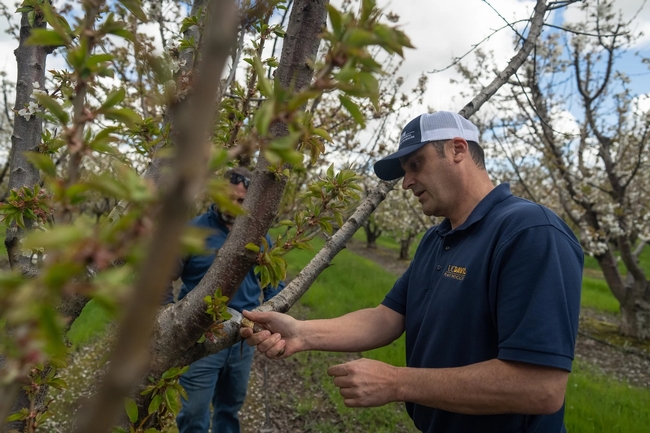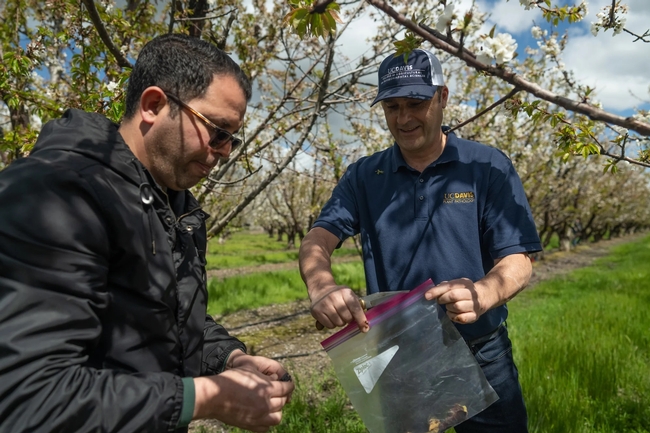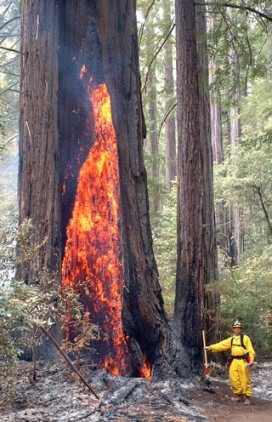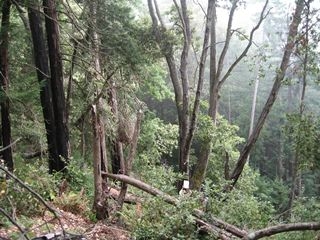Posts Tagged: Phytophthora
Winter atmospheric rivers gave pathogens, diseases path to infect crops
Outbreaks similar to El Niño-influenced issues of the 1990s
The wave of atmospheric rivers that swept across the state this winter has created the right conditions for plant pathogens that haven't been seen for decades in California. University of California, Davis, plant pathologist Florent “Flo” Trouillas is getting more calls from growers and farm advisors concerned about potential crop damage.
“Generally, whenever you have rain events, you're going to have problems,” said Trouillas, a Cooperative Extension specialist who is based at the Kearney Agricultural Research and Extension Center in Parlier. “In wet years we get really busy because most pathogens need and like water.”
Trouillas is like a disease detective. He splits his time between the field and the lab, working to diagnose pathogens, diseases and other ailments that strike fruit and nut crops such as almonds, cherries, olives and pistachios.
On a recent visit to an almond orchard near Fresno, Trouillas joined Mae Culumber, a nut crops farm advisor for UC Cooperative Extension Fresno County. A few weeks earlier, the two had walked the orchard, taking note of the base of some trees that had gumming — a thick, jelly-looking substance indicating a pathogen had taken hold.
“A lot of what Florent is doing is trying to assess patterns on a landscape,” Culumber said. “Sometimes things may look like they are one thing, but it could be another problem.”
When the two returned weeks later, the amber-colored gumming had moved into the canopy, looking like gumballs stuck to branches, some of which were already dead. “It's getting out of control from before,” Trouillas says. “This branch was killed. This is widespread.”
From the field to the lab
Lab testing confirmed what Trouillas believed was the culprit: Phytophthora syringae, a pathogen that can affect almond crops but is rarely seen in California. If it is found, generally the site of infection are wounds caused by pruning, but that is not the case here, where the infection began in the canopy at twigs, or small branches.
It is a threat to a key crop, which according to the California Department of Food and Agriculture, generates $5 billion annually. The last time Phytophthora syringae hit California was in the 1990s after a series of El Niño-influenced storms. Trouillas, who has a photographic memory, remembered reading about it in an old manual.
“It's rare for California and one that we see mostly following atmospheric rivers,” he says.
“The disease will only happen following these extremely wet winters.”
Phytophthora is soilborne, mostly found in tree roots, and doesn't generally spread up into branches. But the intense storms created the right conditions for the pathogen to “swim” up trunks as winds blew spores into the air and rain dropped them back down into the canopy, Trouillas said.
Some of the trees in this orchard will die; others can be saved by pruning infected branches and applying a recommended fungicide, he said.
Identification, diagnosis, education
Trouillas is one of more than 50 Cooperative Extension specialists at UC Davis and each is charged with identifying problems and developing solutions for those issues in support of agriculture, the ecosystem and communities throughout the state.
In his role, Trouillas focuses not only on pathology and research but also on educating growers, nursery staff, pest control advisers and others in agriculture about ways to manage potential threats and how to prevent crop damage.
“His role is very crucial,” said Mohammad Yaghmour, an orchard systems advisor for UC Cooperative Extension Kern County. “He's not only on this mission to educate growers but he's also a source of education for us.”
Trouillas typically conducts one or two site visits a week, usually after a farm advisor reaches out about a problem they can't solve on their own.
“This allows us to be at the forefront of disease detections in California,” he said.
He likens these visits to house calls a doctor would make, only to fields instead. And one of those calls recently took him to a cherry orchard in Lodi.
“These guys help me quite a bit,” said Andrew Vignolo, a pest control adviser with Wilbur-Ellis who asked for a consult. “I bug them a lot.”
The visit starts like any consult in a doctor's office, only the questions come fast as they walk around the Lodi orchard where branches are dying, there is gumming and the trees appear stressed. Some look to be sunburned from exposure. Old pruning wounds show cankers, indicating that past disease treatments didn't get rid of whatever was affecting the trees.
Trouillas asks about the cultivar of the trees because some varieties are more susceptible to pests or diseases. He focuses on stress because that opens the door to disease.
Do they prune in the dormant winter months or in summer when pathogens are more prevalent? Does the soil get tested? How old are the trees? What about nutrition?
“I'm trying to figure out how they got infected so bad,” Trouillas said, walking the orchard. “Bacterial canker is a very mysterious disease.”
He thinks it might be a bacterial canker disease and shaves some bark to take to the lab for testing. He wants to come back next winter to take some samples to see where the pathogen is overwintering.
“We'll know in a few weeks if we have a fighting chance,” Vignolo said.
Be it Lodi, Fresno or elsewhere in the state, Trouillas focuses on local conditions. But what is learned in one field can be passed on to others, providing early warnings or advice for those in similar situations. “All these efforts at collaboration, from the field, to the lab, going through research projects, there's only one goal here — to help the farmers of California.”
Coast redwoods increasingly susceptible to fire damage
California’s renowned coast redwood trees, previously believed to be fireproof, are now more than four times more susceptible to wildfire injury in coastal forest areas infested with the sudden oak death pathogen. These redwoods are now as susceptible to wildfires as other trees.
Millions of trees, including tanoaks, coast live oak, California bay laurels, and many other forest species have been killed by sudden oak death in coastal areas of central and northern California, and Oregon. The pathogen, Phytophthora ramorum, was first linked to the massive tree death in the mid-1990s.
David Rizzo, professor in the Department of Plant Pathology at UC Davis, and his research team are studying how the coastal forest ecology is changing since sudden oak death appeared, and why coast redwoods (Sequoia sempervirens) are subsequently so much more susceptible to fire.
It is the presence of the sudden oak death pathogen in forests that poses heavier fire risks for redwoods.
“If redwoods didn’t live in forests affected by the disease, they could withstand fires just fine,” says Margaret Metz, a postdoctoral research scholar working with Rizzo.
An initial explanation for the higher redwood mortality following wildfires is heavier fuel loads (such as fallen, dead branches from tanoaks) in forests affected by sudden oak death. Tanoak, Notholithocarpus densiflorus, is the primary host dying from sudden oak death and the main source of pathogen inoculum.
According to Rizzo, “The disease likely created more fuel for wildfires as dead tanoak branches fell. The loss of the oaks also would have decreased the amount of shade, drying out the forest and turning it into a tinder box, one not even redwoods could survive.”
A real key, though, is the finding that dead tanoaks, still standing, carry flames high into tree canopies, scorching the crowns of adjacent redwood trees. It’s this crown injury that is believed to have caused so many redwood trees to die in a number of fires that occurred in 2008.
Rizzo, noting that an increase in fire severity is resulting from climate change and global movement of species, says, “There may be all sorts of consequences, among them, dead and dying coast redwoods.”
Additional information:
- California's iconic redwoods in danger from fire and infectious disease. National Science Foundation report on Rizzo group’s work, August 2013
- The effects of sudden oak death and wildfire on forest composition and dynamics in the Big Sur ecoregion of coastal California. General technical report
- Ecology research article, Ecological Society of America
- California Oak Mortality Task Force website
UC Berkeley scientist surprised by SOD incidence
The Forest Pathology and Mycology Laboratory at UC Berkeley used 10,000 tree and plant samples collected by 500 citizens between April and June to document a dramatic increase in the Sudden Oak Death infection rate from Napa to the Carmel Valley, according to the San Francisco Chronicle.
"We found that the number of positives were double and in some cases triple what they were last year," said Matteo Garbelotto, the UC Berkeley forest pathologist who organizes the annual surveys. "We were surprised. That was a big jump."
Old Farmer's Almanac: 220 years of useful advice
Sam McManis, Sacramento Bee
The Sacramento Bee ran a feature story yesterday about the 220-year-old "Old Farmer's Almanac." The article said that most readers of the publication these days are not farmers. When the Bee contacted the California Farm Bureau Federation to find farmers who use the almanac as part of their work or even just for entertainment, its spokeswomen suggested asking Chuck Ingels, farm advisor and director of UC Cooperative Extension in Sacramento County.
"I honestly have never looked at the almanac, but I've seen it on bookshelves," Ingels said. "It's never mentioned by the farmers I'm in contact with."
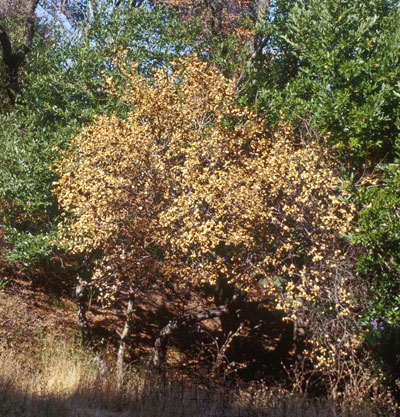
Dramatic increase in Northern California Sudden Oak Death.
Sudden Oak Death appears in San Francisco's Presidio
A coast live oak tree on the southeastern edge of the Presidio National Park in San Francisco was found to have Sudden Oak Death disease, according to an article in the San Francisco Chronicle.
The disease was believed to have made its way to the tree from an ornamental plant at a nearby home, reported Matteo Garbelotto of UC Berkeley's Forest Pathology and Mycology Laboratory. Scientists are concerned about the find because it means the microbe escaped from an ornamental and infected a wild tree despite an intensive nationwide effort to control the disease in nurseries.
“I was surprised by the finding because the Presidio is located in an urban setting, far from any other known infestation,” Garbelotto was quoted in a news release from the California Oak Mortality Task Force. “With a few exceptions, all known infestations are close to oak woodlands or redwood forests.”
The infected oak is one of the few native trees in the Presidio, wrote Chronicle reporter Peter Fimrite. Of the 60,000 trees in 300-acre park, only about 200 are native oaks.
The infected tree was discovered by an arborist for the Presidio Trust. The Garbelotto lab took samples, which showed a strain of sudden oak death that is normally seen only in ornamental plants. Laboratory workers tested other trees, plants and soil samples from the same area, but no evidence of the pathogen was found.
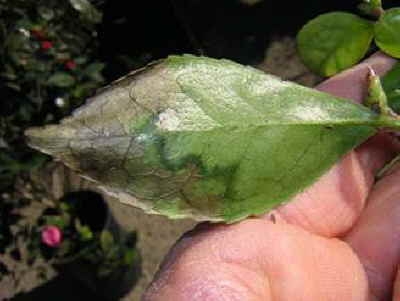
Camellia leaf infected with the pathogen that causes Sudden Oak Death.
Berkeley lab tracks Sudden Oak Death with citizen help
Scientists at UC Berkeley are using tree and plant samples collected by citizens over the past two years to document Bay Area infestations of Sudden Oak Death, reported the San Francisco Chronicle.
"Last year we had about 240 participants and collected over 1,000 samples. These results were placed on a map so people can see where the positives are," UC Berkeley forest pathologist Matteo Garbelotto was quoted. "This is part of the solution. If we educate and involve individual property owners, we can make a really big difference."
The UC survey documents the following SOD spread:
- In Atherton, Oakland, Hercules and Mill Valley
- In Hercules-Pinole area, Orinda, Moraga and in Redwood Regional Park, Wildcat Canyon and Tilden Park
- Creeping toward south Oakland
- Recolonizing the Berkeley campus after it was thought to have been eliminated nine years ago
- Moving southward and eastward along the Peninsula, infesting Woodside and Los Altos
- All over Tamalpais Valley in Marin County
- West of Healdsburg and Windsor in Sonoma County
- In several trees on the edge of Carmel Valley Village
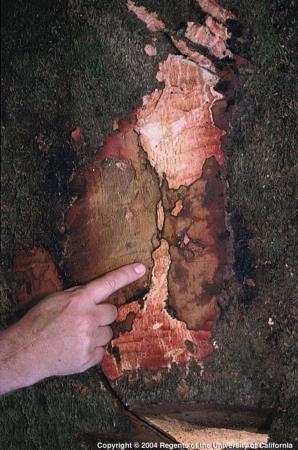
Discoloration characteristic of infection by Phytophthora ramorum, which causes SOD.

